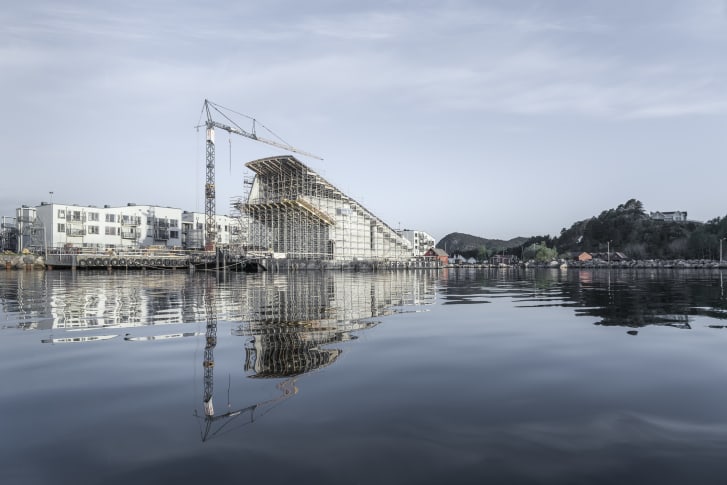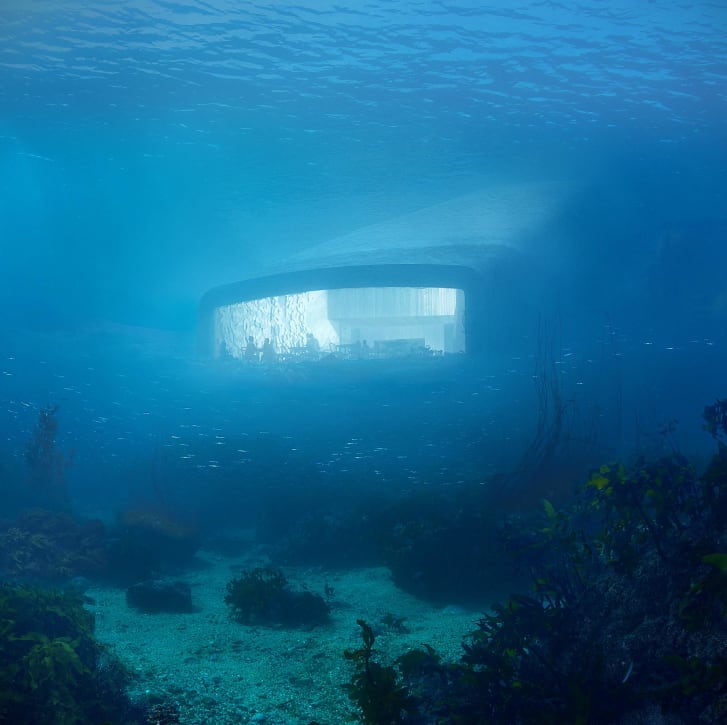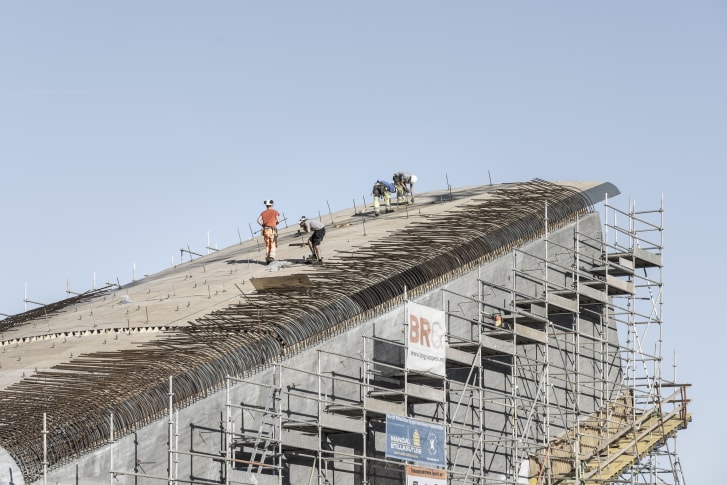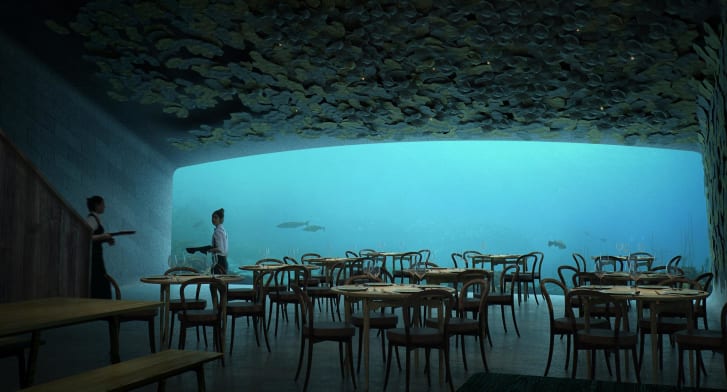The restaurant, called Under, is the design of Norwegian outfit Snøhetta, which has made a name for itself with projects such as the Bibliotheca Alexandrina in Egypt, the Oslo Opera House, the National September 11 Memorial Pavilion and the renovation of Times Square in New York.
When finished, the structure will accommodate about 100 guests with a total internal area of about 500 square meters (5,300 square feet) set over three levels, offering unique underwater views of the surrounding marine environment through a 11-meter (36 feet) wide panoramic window.
Under goes under
The restaurant was built in about six months on a barge near the coast, then towed into position — about 600 feet away — with a heavy-lift vessel. To submerge the structure, containers filled with water were placed inside, before securing it to the sea floor with a total of 18 anchoring points.
Under under construction. Credit: Aldo Amoretti
“It was a delicate operation, as the clearance to meet the bolts was just two inches,” Rune Grasdal, a senior architect at Snøhetta, said in a phone interview.
The ‘prefab’ housing resurgence rolls on
Under is made of reinforced concrete, to withstand the harsh conditions found in this spot of the Norwegian coastline. “The first problem is water pressure, as we’re five meters (16 feet) below the surface, but the biggest challenge is the waves. Wind and waves are extreme here. To withstand all these forces, the building is slightly curved, so it can better take to the waves, and it’s thick: half a meter (1.6 feet) for the concrete and about 30 centimeters (1 foot) for the acrylic windows,” said Grasdal.
An artist’s impression of the finished restaurant. Credit: Snohetta
The decision to position the restaurant in an area battered by the elements was deliberate. “When the client came to us, they had already done some sketches on another site close to current one, but we convinced them to build a few hundred meters away, where the sea is actually rougher. We thought this would better capture the nature of the area and I think that’s also what makes this more spectacular compared to other underwater restaurants in the world, as they are in very controlled areas,” said Grasdal.
Architect creates ‘prehistoric’ dining experience in downtown Tokyo
The client, developers Gaute and Stig Ubostad, also operates a hotel a short distance from the restaurant. They both sit in the Lindesnes region, home to Norway’s oldest lighthouse, a popular tourist attraction located at the southernmost tip of of the mainland. Getting here isn’t too easy: the best way is to hop on a short flight from Oslo to Kristiansand, the closest airport, which is about an hour’s drive away. Grasdal said that a boat service is in the works.
Inside the world’s quietest room
A detail of the construction site. Credit: Aldo Amoretti
A light touch
To guarantee the safety of the guests, an analysis has been performed to study the propagation and load of the waves, and the 2,500-ton structure is designed to withstand the most extreme events. The data will also be fed back to visiting research teams that study marine biology and fish behavior. Work has been done to restore the conditions that were in place prior to the disturbance created by submerging the structure, and the concrete shell is designed to invite mussels to cling onto it and blend into the surrounding nature.
The tasting menu, created by Danish head chef Nicolai Ellitsgaard Pedersen, is still under wraps but will rely heavily on local seafood, although mushrooms, berries, various seabirds and wild sheep from the surrounding landscape will also be on offer.
From the main window in the dining area, which is 4 meters (13 feet) tall, guests will be able to observe a variety of fish and sea creatures including seals and lobsters. Crucial to this view is the lighting, which has been carefully designed for both the interior and the sandbank just outside. “Outside lighting is very important because in the wintertime and in the evenings it will be dark, and without any light you would just see the reflection of the restaurant on the window,” said Grasdal.
An artist’s impression of the dining area. Credit: Snohetta
Interior lighting is muted and discreet to avoid such reflections, and colors are chosen accordingly, with oak wood and fabric covering the walls to avoid glaring white spots.
The most remote fine dining experience in the world?
“It’s a magic feeling to be down in a big room like this and see out into the sea through the huge window And what’s surprising is that some of the renderings we did illustrate very closely what it’s going to be like,” said Grasdal.
The restaurant is accepting reservations starting in April 2019, although availability is already limited well into the summer. According to Grasdal, however, the best way to plan a visit is looking at the weather forecast. “I think the most exciting experience will be visiting the restaurant during rough weather,” he said.
“It will be fantastic to see the sea surface broken up by the big waves and the rain, making for a very dramatic view — although you will still feel safe and relaxed inside the restaurant.”




